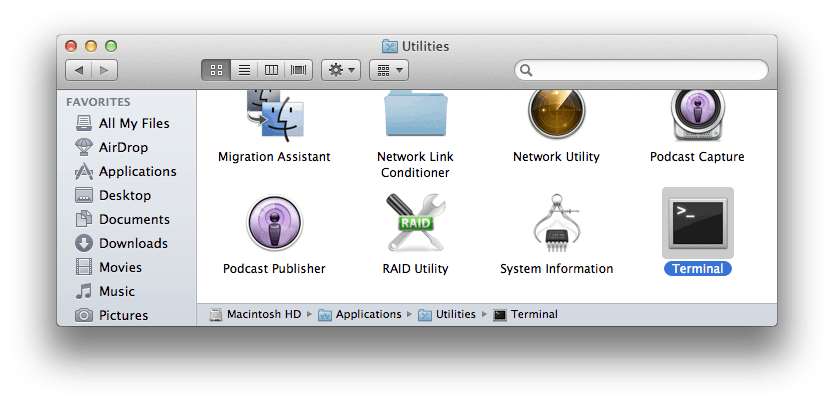

- #Os x open in terminal how to
- #Os x open in terminal mac os x
- #Os x open in terminal manual
- #Os x open in terminal mac
Note that many commands in Terminal can accept various options (sometimes called switches) that can alter their effect.
#Os x open in terminal how to
The current directory (the “working directory”) when you open Terminal always defaults to your Home Folder.īefore we describe how to check and terminate a process on your computer it’s worth knowing a few basic Terminal commands. The command prompt always begins with your computer name followed by your local Account Name. The second line is the command prompt which is where you enter the commands you wish to execute. The first line shows the date and time when you last logged in. Once it opens you’ll be presented with a standard Terminal window as below. Terminal is always represented by the icon below. The first step is to open Terminal either from the Applications -> Utilities folder or simply type Terminal into Spotlight. The Activity Monitor Application How to Use Terminal
#Os x open in terminal mac
Note that process ID’s are assigned by Mac OS, and therefore will not be the same on your computer as somebody else’s. The Apple Mail application is displayed in Activity Monitor with a PID number of 14649. From here you can inspect or quit each process, but in this example we use Activity Monitor simply as a companion to Terminal. The main Activity Monitor window is shown below.Įach application on your Mac has an associated Process ID (a PID) and a user-friendly name. When used together, Activity Monitor and Terminal provide a powerful yet relatively straightforward way to inspect and manage wayward processes. Activity Monitor shows common process-related details such as the memory used and percentage of CPU that each process is consuming. Terminal is a text-based tool which lets you conduct all manner of routine tasks such as viewing directories, copying, moving and deleting files, as well as obtain detailed information about each process running including:Ī related indispensable application is Activity Monitor – a graphical tool that allows you to manage processes, however it doesn’t have quite the same capabilities that Terminal does.
#Os x open in terminal mac os x
Terminal was used by Apple as a showcase for macOS graphics APIs in early advertising of Mac OS X, offering a range of custom font and coloring options, including transparent backgrounds.Probably the most useful tool to check and kill processes is called Terminal, which is an application that provides access to the lower levels of the Mac OS X operating system and files.
#Os x open in terminal manual
These include the ability to use the standard macOS Help search function to find manual pages and integration with Spotlight. Terminal includes several features that specifically access macOS APIs and features. These settings do not alter the operation of Terminal, and the xterm settings do not match the behavior of xterm. Available options are ansi, dtterm, nsterm, rxvt, vt52, vt100, vt102, xterm, xterm-16color and xterm-256color, which differ from the OS X 10.5 (Leopard) choices by dropping the xterm-color and adding xterm-16color and xterm-256color. The preferences dialog for Terminal.app in OS X 10.8 (Mountain Lion) and later offers choices for values of the TERM environment variable. The user can choose other shells available with macOS, such as the KornShell, tcsh, and bash.

Īs a terminal emulator, the application provides text-based access to the operating system, in contrast to the mostly graphical nature of the user experience of macOS, by providing a command-line interface to the operating system when used in conjunction with a Unix shell, such as zsh (the default shell in macOS Catalina ). Terminal originated in NeXTSTEP and OPENSTEP, the predecessor operating systems of macOS. Terminal ( Terminal.app) is the terminal emulator included in the macOS operating system by Apple. Terminal 2.2 running the top program under macOS


 0 kommentar(er)
0 kommentar(er)
